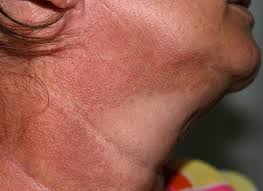Poikiloderma .. What is it?

David T. Harvey, MD Mohs Surgeon & Cosmetic Dermatologist
Poikiloderma of Civatte refers to the reddish brown discoloration of the neck and chest that occurs in middle aged and fair complected females. 1923 was the first time that poikiloderma was described in the medical literature.
This skin condition is due to sun exposure or aging and not due to any specific disease. Common skin changes are pigment changes, skin thinning, and redness which spares the neck midline.
Most of the time, poikiloderma is asymptomatic. In some instances, burning, itching and increased skin sensitivity occurs.
The specific cause of this disorder is multifactorial. Photodamage, low estrogen, and a genetic predisposition have all been thought to contribute to the development of poikiloderma.
The treatment of this poikiloderma is difficult. The most important therapy is to use a broad spectrum sunscreen with an SPF of at least 30. In addition, topical Retin A, green tea serums and vitamin C preparations have been tried and in some instances have proven useful.
For resistant cases, intense pulse light, pulse dye, photodynamic therapy and fractional resurfacing lasers have been used. Several treatment sessions are often required to improve the condition.


